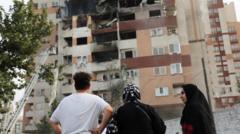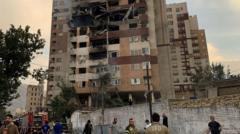In a significant escalation of hostilities, Israel has initiated airstrikes on critical Iranian nuclear sites, raising alarms over regional security and the potential for nuclear proliferation.
**Renewed Strikes on Iranian Nuclear Facilities Escalate Tensions in the Middle East**

**Renewed Strikes on Iranian Nuclear Facilities Escalate Tensions in the Middle East**
Israeli airstrikes target Iran's key nuclear sites amid heightened conflict, with international observers concerned.
Over the past few days, Israel has executed a series of air assaults aimed at Iran's vital nuclear infrastructure, further intensifying existing tensions in the Middle East. Key facilities involved include the infamous Natanz uranium enrichment site, which has been at the center of multiple international controversies and past cyberattacks, including the notorious Stuxnet incident.
The Natanz facility, positioned around 140 miles south of Tehran, is a pivotal location for Iran's uranium enrichment activities. Experts report that although the damage inflicted is significant, the exact extent remains to be assessed. Notably, International Atomic Energy Agency (IAEA) Director Rafael Grossi confirmed that although Natanz was struck, no radiation leaks have been detected — a more hopeful outcome under the circumstances. Nonetheless, he condemned military actions against nuclear facilities as dangerous and heedless of the potential consequences for regional and global stability.
Meanwhile, the Fordow facility, known for its robust defenses, appears to have escaped the bombardment, suggesting that Israel's military operations may not be able to compromise every fortified site without substantial external support, likely from American military assets.
Other installations, such as Parchin, where Iran has allegedly conducted tests relevant to nuclear warhead development, and the Bushehr power plant, which currently operates with Russian aid, remain under scrutiny as the international community watches closely.
As the situation unfolds, observers predict that these developments could lead to a reevaluation of diplomatic relations with Iran, amid fears that heightened military engagement could lead to broader conflict in an already volatile region. With Iran's commitment to advancing its nuclear program, the stakes remain high, leaving many to question what the future holds for nuclear diplomacy and regional security in the Middle East.
The Natanz facility, positioned around 140 miles south of Tehran, is a pivotal location for Iran's uranium enrichment activities. Experts report that although the damage inflicted is significant, the exact extent remains to be assessed. Notably, International Atomic Energy Agency (IAEA) Director Rafael Grossi confirmed that although Natanz was struck, no radiation leaks have been detected — a more hopeful outcome under the circumstances. Nonetheless, he condemned military actions against nuclear facilities as dangerous and heedless of the potential consequences for regional and global stability.
Meanwhile, the Fordow facility, known for its robust defenses, appears to have escaped the bombardment, suggesting that Israel's military operations may not be able to compromise every fortified site without substantial external support, likely from American military assets.
Other installations, such as Parchin, where Iran has allegedly conducted tests relevant to nuclear warhead development, and the Bushehr power plant, which currently operates with Russian aid, remain under scrutiny as the international community watches closely.
As the situation unfolds, observers predict that these developments could lead to a reevaluation of diplomatic relations with Iran, amid fears that heightened military engagement could lead to broader conflict in an already volatile region. With Iran's commitment to advancing its nuclear program, the stakes remain high, leaving many to question what the future holds for nuclear diplomacy and regional security in the Middle East.


















